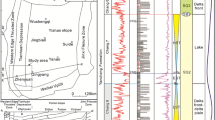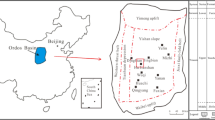Abstract
This study examines the characteristics and pore evolution of the Baikouquan conglomerate reservoir in the Mahu sag of the Junggar Basin from original sedimentation and diagenesis. Analysis is based on core observation, thin section, X-ray diffraction, cathodoluminescence and image analysis, and combined with physical property and well log data. The results show that conglomerate reservoir in the Baikouquan Formation can be divided into three lithofacies types: Type I is argillaceous filling conglomerate facies, in which cementation and dissolution are not developed, and the interstitial material is mainly argillaceous; Type II is tuffaceous filling in fine conglomerate facies, in which volcanic rock debris, illite and dissolution are developed; Type III is sandstone filling conglomerate facies, in which cementation and dissolution are developed. The reservoir undergoes complex diagenesis, and the diagenetic sequence is: compaction→early chlorite film→early calcite cementation→detritus, feldspar and tuffaceous dissolution→quartz secondary enlargement→late calcite cementation→oil invasion→forming illite. Quantitative study of pore evolution shows that dissolution and calcite cementation are relatively developed in lithofacies Type III, and that compaction has a great influence on lithofacies Type I and II. According to comprehensive evaluation of lithofacies, diagenesis and pore structure characteristics, the reservoir space type is mainly the dissolution pore. It is mainly primarily mainly composed of lithofacies Type III, thickness of the gravel body is more than 25 m, porosity is generally more than 12%, which represents favorable conditions for the distribution of favorable reservoir.
Similar content being viewed by others
References Cited
Arnott, R. W. C., 2003. The Role of Fluid- and Sediment-Gravity Flow Processes during Deposition of Deltaic Conglomerates (Cardium Formation, Upper Cretaceous), West-Central Alberta. Bulletin of Canadian Petroleum Geology, 51(4): 426–436. https://doi.org/10.2113/51.4.426
Bjørlykke, K., 1998. Clay Mineral Diagenesis in Sedimentary Basins—A Key to the Prediction of Rock Properties. Examples from the North Sea Basin. Clay Minerals, 33(1): 15–34. https://doi.org/10.1180/claymin.1998.033.1.03
Bjørlykke, K., Jahren, J., 2012. Open or Closed Geochemical Systems during Diagenesis in Sedimentary Basins: Constraints on Mass Transfer during Diagenesis and the Prediction of Porosity in Sandstone and Carbonate Reservoirs. AAPG Bulletin, 96(12): 2193–2214. https://doi.org/10.1306/04301211139
Blair, T. C., McPherson, J. G., 1999. Grain-Size and Textural Classification of Coarse Sedimentary Particles. Journal of Sedimentary Research, 69(1): 6–19. https://doi.org/10.2110/jsr.69.6
Cai, J. G., Xie, Z. H., Tian, F., et al., 2002. Diagenesis and Pore Evolution of Deep Sandstones in Jiyang Depression. Oil & Gas Geology, 23(1): 84–88 (in Chinese with English Abstract)
Chen, B., Wang, Z. T., Kang, L., et al., 2016. Diagenesis and Pore Evolution of Triassic Baikouquan Formation in Mabei Region, Junggar Basin. Journal of Jilin University (Earth Science Edition), 46(1): 23–35. https://doi.org/10.13278/j.cnki.jjuese.201601103 (in Chinese with English Abstract)
Cronin, B. T., Kidd, R. B., 1998. Heterogeneity and Lithotype Distribution in Ancient Deep-Sea Canyons: Point Lobos Deep-Sea Canyon as a Reservoir Analogue. Sedimentary Geology, 115(1/2/3/4): 315–349. https://doi.org/10.1016/s0037-0738(97)00099-7
He, C. Y., Zhang, C. R., 2017. The World’s Largest Conglomerate Oil Field Discovered in Junggar Basin, Xinjiang. Geology in China, 44(6):1174 (in Chinese with English Abstract)
Hentz, T. F., Ambrose, W. A., Carr, D. L., 2012. Reservoir Systems of the Pennsylvanian Lower Atoka Group (Bend Conglomerate), Northern Fort Worth Basin, Texas: High-Resolution Facies Distribution, Structural Controls on Sedimentation, and Production Trends. AAPG Bulletin, 96(7): 1301–1332. https://doi.org/10.1306/10041111078
Huang, L. J., Tang, Y., Chen, Y. B., et al., 2015. The Subfacies Boundary Description of Fan Delta under the Control of Sequence Stratigraphy of Triassic Baikouquan Formation in the Mahu Slope Area, Junggar Basin. Natural Gas Geoscience, 26(S1): 25–32 (in Chinese with English Abstract)
Jia, H. B., Ji, H. C., Wang, L. S., et al., 2017. Reservoir Quality Variations within a Conglomeratic Fan-Delta System in the Mahu Sag, Northwestern Junggar Basin: Characteristics and Controlling Factors. Journal of Petroleum Science and Engineering, 152: 165–181. https://doi.org/10.1016/j.petrol.2017.03.002
Jin, J., Kang, X., Hu, W. X., et al., 2017. Diagenesis and Its Influence on Coarse Clastic Reservoirs in the Baikouquan Formation of Western Slope of the Mahu Depression, Junngar Basin. Oil & Gas Geology, 38(2): 323–333, 406 (in Chinese with English Abstract)
Kang, X., Hu, W. X., Cao, J., et al., 2018. Selective Dissolution of Alkali Feldspars and Its Effect on Lower Triassic Sandy Conglomerate Reservoirs in the Junggar Basin, Northwestern China. Geological Journal, 53(2): 475–499. https://doi.org/10.1002/gj.2905
Lai, J., Wang, G. W., Wang, S., et al., 2018. Review of Diagenetic Facies in Tight Sandstones: Diagenesis, Diagenetic Minerals, and Prediction via Well Logs. Earth-Science Reviews, 185: 234–258. https://doi.org/10.1016/j.earscirev.2018.06.009
Lee, M., Aronson, J. L., Savin, S. M., 1985. K/Ar Dating of Time of Gas Emplacement in Rotliegendes Sandstone, Netherlands. AAPG Bulletin, 69(9): 1381–1385. https://doi.org/10.1306/ad462c68-16f7-11d7-8645000102c1865d
Li, W., Hu, J. M., Qu, H. J., 2009. Discussion on Mesozoic Basin Boundary of the Northern Junggar Basin, Xinjiang. Journal of Northwest University (Natural Science Edition), 39(5): 821–830 (in Chinese with English Abstract)
Liu, G. D., Chen, Z. L., Wang, X. L., et al., 2016. Migration and Accumulation of Crude Oils from Permian Lacustrine Source Rocks to Triassic Reservoirs in the Mahu Depression of Junggar Basin, NW China: Constraints from Pyrrolic Nitrogen Compounds and Fluid Inclusion Analysis. Organic Geochemistry, 101: 82–98. https://doi.org/10.1016/j.orggeochem.2016.08.013
MacQuaker, J. H. S., Taylor, K. G., Keller, M., et al., 2014. Compositional Controls on Early Diagenetic Pathways in Fine-Grained Sedimentary Rocks: Implications for Predicting Unconventional Reservoir Attributes of Mudstones. AAPG Bulletin, 98(3): 587–603
McBride, E. F., 1989. Quartz Cement in Sandstones: A Review. Earth-Science Reviews, 26(1/2/3): 69–112. https://doi.org/10.1016/0012-8252(89)90019-6
Meng, X. C., Chen, N. G., Wang, H. M., et al., 2015. Sedimentary Characteristics of Glutenite and Its Favourable Accumulation Facies: A Case Study from T1b, Mabei Slope, Junggar Basin. Acta Sedimentologica Sinica, 33(6): 1235–1246. https://doi.org/10.14027/jxnki.cjxb.2015.06.016 (in Chinese with English Abstract)
Morad, S., Al-Ramadan, K., Ketzer, J. M., et al., 2010. The Impact of Diagenesis on the Heterogeneity of Sandstone Reservoirs: A Review of the Role of Depositional Facies and Sequence Stratigraphy. AAPG Bulletin, 94(8): 1267–1309. https://doi.org/10.1306/04211009178
Pan, C. C., Zhou, Z. Y., Fan, S. F., et al., 1997. Thermal History of Junggar Basin. Geochimica, 26(6): 1–7. https://doi.org/10.19700/j.0379-1726.1997.06.001 (in Chinese with English Abstract)
Pan, J. G., Wang, G. D., Qu, Y. Q., et al., 2015. Formation Mechanism and Characteristics of Sandy Conglomerate Diagenetic Trap: A Case Study of the Triassic Baikouquan Formation in the Mahu Sag, Junggar Basin. Natural Gas Geoscience, 26(S1): 41–49 (in Chinese with English Abstract)
Peltonen, C., Marcussen, Ø., Bjørlykke, K., et al., 2009. Clay Mineral Diagenesis and Quartz Cementation in Mudstones: The Effects of Smectite to Illite Reaction on Rock Properties. Marine and Petroleum Geology, 26(6): 887–898. https://doi.org/10.1016/j.marpetgeo.2008.01.021
Qi, W., Pan, J. G., Wang, G. D., et al., 2015. Fluid Inclusion and Hydrocarbon Charge History for the Reservoir of Baikouquan Formation in the Mahu Sag, Junggar Basin. Natural Gas Geoscience, 26(S1): 64–71 (in Chinese with English Abstract)
Shi, J. A., He, Z., Ding, C., et al., 2010. Sedimentary Characteristics and Model of Permian System in KeBai Area in the Northwestern Margin of Jungar Basin. Acta Sedimentologica Sinica, 28 (5): 962–968 (in Chinese with English Abstract)
Shi, Z. S., Li, X. Z., Dong, D. Z., et al., 2018. Diagenesis and Pore Evolution of Tight Sandstone Reservoir: A Case Study from the Upper Triassic Reservoir of the Southwest Sichuan Basin, China. Earth Science Frontiers, 25(2): 179–190 (in Chinese with English Abstract)
Southgate, P. N., Kyser, T. K., Scott, D. L., et al., 2006. A Basin System and Fluid-Flow Analysis of the Zn-Pb-Ag Mount Isa-Type Deposits of Northern Australia: Identifying Metal Source, Basinal Brine Reservoirs, Times of Fluid Expulsion, and Organic Matter Reactions. Economic Geology, 101(6): 1103–1115. https://doi.org/10.2113/gsecongeo.101.6.1103
Stixrude, L., Peacor, D. R., 2002. First-Principles Study of Illite-Smectite and Implications for Clay Mineral Systems. Nature, 420(6912): 165–168. https://doi.org/10.1038/nature01155
Tan, C. P., Yu, X. H., Liu, B. B., et al., 2017. Conglomerate Categories in Coarse-Grained Deltas and Their Controls on Hydrocarbon Reservoir Distribution: A Case Study of the Triassic Baikouquan Formation, Mahu Depression, NW China. Petroleum Geoscience, 23(4): 403–414. https://doi.org/10.1144/petgeo2016-017
Tang, Y., Xu, Y., Zhai, J. H., et al., 2014. Fan-Delta Group Characteristics and Its Distribution of the Triassic Baikouquan Reservoirs in Mahu Sag of Junggar Basin. Xinjiang Petroleum Geology, 35: 628–635 (in Chinese with English Abstract)
Xiao, M., Wu, S. T., Yuan, X. J., et al., 2020. Diagenesis Effects on the Conglomerate Reservoir Quality of the Baikouquan Formation, Junggar Basin, China. Journal of Petroleum Science and Engineering, 195: 107599. https://doi.org/10.1016/j.petrol.2020.107599
Xiao, M., Yuan, X. J., Cheng, D. W., et al., 2018. Feldspar Dissolution and Its Influence on Reservoirs: A Case Study of the Lower Triassic Baikouquan Formation in the Northwest Margin of the Junggar Basin, China. Geofluids, 2018: 1–19. https://doi.org/10.1155/2018/6536419
Xiao, M., Yuan, X. J., Wu, S. T., et al., 2019. Conglomerate Reservoir Characteristics of and Main Controlling Factors for the Baikouquan Formation, Mahu Sag, Junggar Basin. Earth Science Frontiers, 26(1): 212–224 (in Chinese with English Abstract)
Yu, X. H., Qu, J. H., Tan, C. P., et al., 2014. Conglomerate Lithofacies and Origin Models of Fan Deltas of Baikouquan Formation in Mahu Sag, Junggar Basin. Xinjiang Petroleum Geology, 35(6): 619–627 (in Chinese with English Abstract)
Yu, Y. J., Hu, S. Y., Lei, Z. Y., et al., 2005. Sedimentary Response to Triassic-Jurassic Thrust Faulting in the Foreland Thrust Belt of the Northwestern Junggar Basin. Earth Science Frontiers, 12(4): 423–437 (in Chinese with English Abstract)
Zhang, S. C., Zou, N. N., Shi, J. A., et al., 2015. Depositional Model of the Triassic Baikouquan Formation in Mabei Area of Junggar Basin. Oil & Gas Geology, 36(4): 640–650 (in Chinese with English Abstract)
Zhang, Y. J., Cao, J., Hu, W. X., 2010. Timing of Petroleum Accumulation and the Division of Reservoir-Forming Assemblages, Junggar Basin, NW China. Petroleum Exploration and Development, 37(3): 257–262. https://doi.org/10.1016/s1876-3804(10)60031-6
Zhu, S. F., Zhu, X. M., Wang, Y. B., et al., 2010. Dissolution Characteristics and Pore Evolution of Triassic Reservoir in Ke-Bai Area, Northwestern Margin of Junggar Basin. Acta Sedimentologica Sinica, 28(3): 547–555. https://doi.org/10.14027/j.cnki.cjxb.2010.03.018 (in Chinese with English Abstract)
Acknowledgments
This study was financially supported by the China National Science and Technology Major Projects (No. 2017ZX05001), the PetroChina Science and Technology Major Projects (No. 2016B-0304) and China Postdoctoral Science Foundation (No. 2020M680819). The final publication is available at Springer via https://doi.org/10.1007/s12583-020-1083-6.
Author information
Authors and Affiliations
Corresponding author
Rights and permissions
About this article
Cite this article
Xiao, M., Wu, S., Yuan, X. et al. Conglomerate Reservoir Pore Evolution Characteristics and Favorable Area Prediction: A Case Study of the Lower Triassic Baikouquan Formation in the Northwest Margin of the Junggar Basin, China. J. Earth Sci. 32, 998–1010 (2021). https://doi.org/10.1007/s12583-020-1083-6
Received:
Accepted:
Published:
Issue Date:
DOI: https://doi.org/10.1007/s12583-020-1083-6




